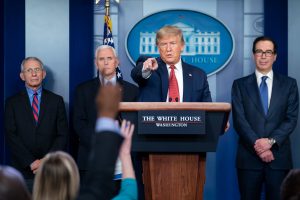By Dingding Chen
 Against the backdrop of the COVID-19 global pandemic, the major task of governments around the world for the near future is and will be to restore their ravaged national economies. This will include solving domestic unemployment problems, revitalizing tertiary industry, and restoring the supply chains of various industries. In addition to economic issues, many of America’s traditional allies and partners, led by the European Union, will face a domestic political shakeup during this year or the next. For example, many European Union member states, led by Italy and Austria, have been caught in the political conflicts between populist parties and elite parties. Frequent turnover in ruling parties also makes it difficult for these countries to maintain consistency and continuity in policies.
Against the backdrop of the COVID-19 global pandemic, the major task of governments around the world for the near future is and will be to restore their ravaged national economies. This will include solving domestic unemployment problems, revitalizing tertiary industry, and restoring the supply chains of various industries. In addition to economic issues, many of America’s traditional allies and partners, led by the European Union, will face a domestic political shakeup during this year or the next. For example, many European Union member states, led by Italy and Austria, have been caught in the political conflicts between populist parties and elite parties. Frequent turnover in ruling parties also makes it difficult for these countries to maintain consistency and continuity in policies.
Therefore, it is not only the United States, but most countries around the world that will need to work on alleviating domestic political tensions and revitalizing national economies in the post-pandemic era ahead. In addition, they will need to deal with the increasingly severe climate change problem. Within the diplomatic field, reducing conflicts between countries and focusing on reorganizing their own domestic problems is also the choice most countries will take, which also fits the interests of their citizens. In this background, even if the United States hopes to continue to contain China, it would be really hard for Washington to find any partner will to join it in the world — a partner who is willing to spend the opportunity cost and national resources to team up against China. Therefore, it will be even more difficult for the United States to build an international united front, geopolitically and globally, to contain China in the short term.
Ultimately, the future relationship between China and the United States is still based on cyclical fluctuations of competition and cooperation.
In the 2017 White House National Security Strategy report, China was defined as a “strategic competitor,” a “revisionist state,” and a “regime in need of repression.” In May 2020, the White House released another 16-page U.S. Strategic Approach to China document, which was not much new compared with the 2017 US National Security Strategy report. It did not actively define China as a more serious threat, nor did it clearly emphasize an easing attitude toward China. It can be seen that from 2018 to 2020, the United States’ repressive policy toward China has not fundamentally changed China-U.S. relations. On one hand, the United States could not really complete economic “decoupling” with China. On the other hand, it has not given up any attempts on containment policies. So in the short term, the friction between China and the United States in the next few years will still emerge, but both sides will not enter all-out confrontation. The United States will be cautious in suppressing China too heavily, due to the potential concern of blowback on its domestic economy.
To sum up, the competition and cooperation between the two countries will continue and both will coexist for quite a long time. One of the main reasons for this, from the comparative structural power theory perspective, is that the two countries have not reached an equivalent level on comprehensive strength. China, in terms of economic strength, technological strength, military, education, financial power, and global political power needs at least 10 years to match up with the United States. At the same time, the United States, under the attack of unilateralism and COVID-19, has no power to mobilize an international united front against China. The two-year trade war has yielded no tangible results, and the United States is not capable of containing and crushing China on its own. Therefore, the confrontation between China and the United States in the future will become a relatively deadlocked situation, and this will fluctuate within a certain range, just as fluctuation rules the economic cycle. Things will be sometimes tense and sometimes mild.
Based on the factors outlined in this series, we should cautiously and optimistically view the possibility of a period of détente after this election year. This situation would fall in line with the interests of the leadership in both countries, for the restoration and consolidation on economic and political order affected by the pandemic. Coordination, standoff, and cyclical fluctuations will very likely become normal in the future of China-U.S. relations.
No comments:
Post a Comment